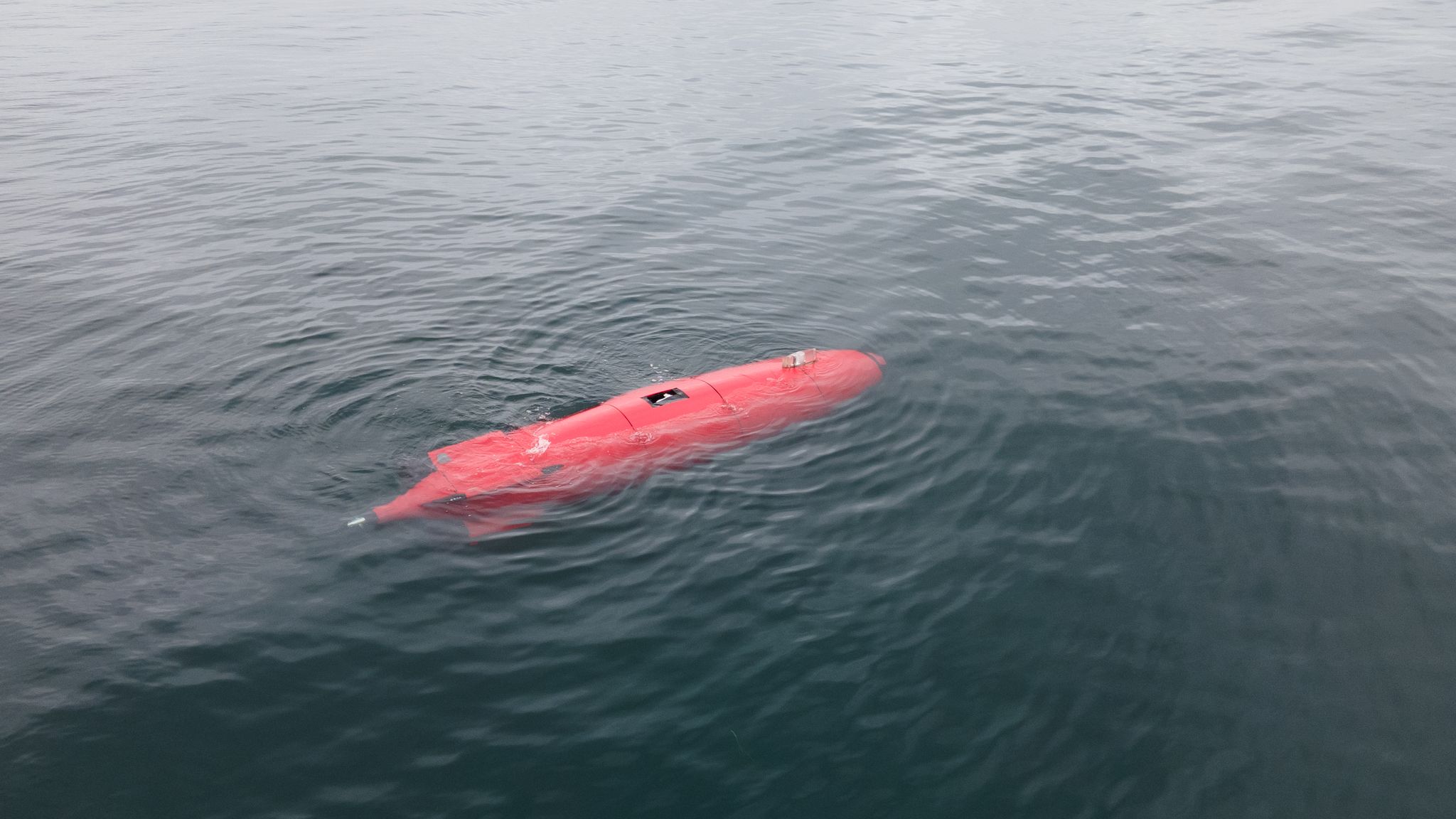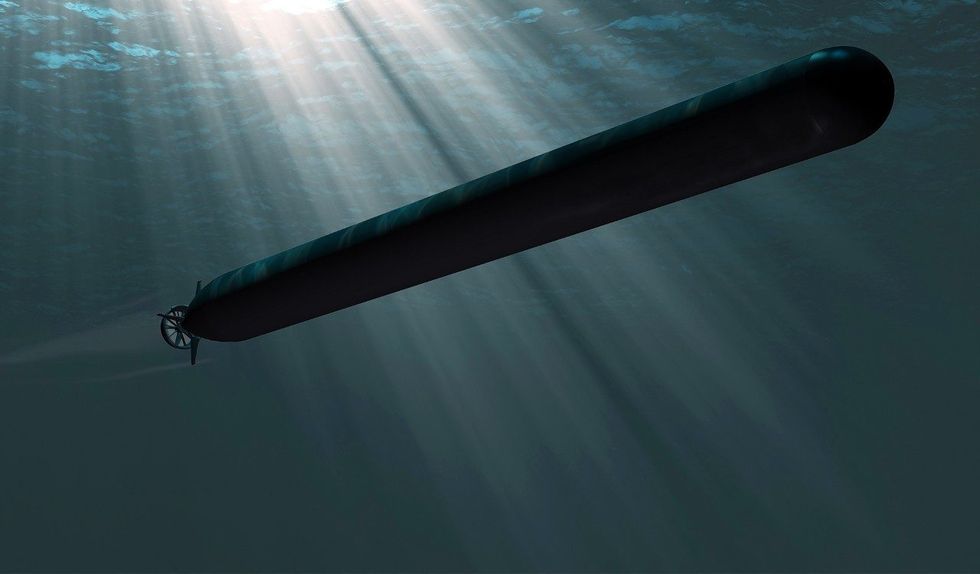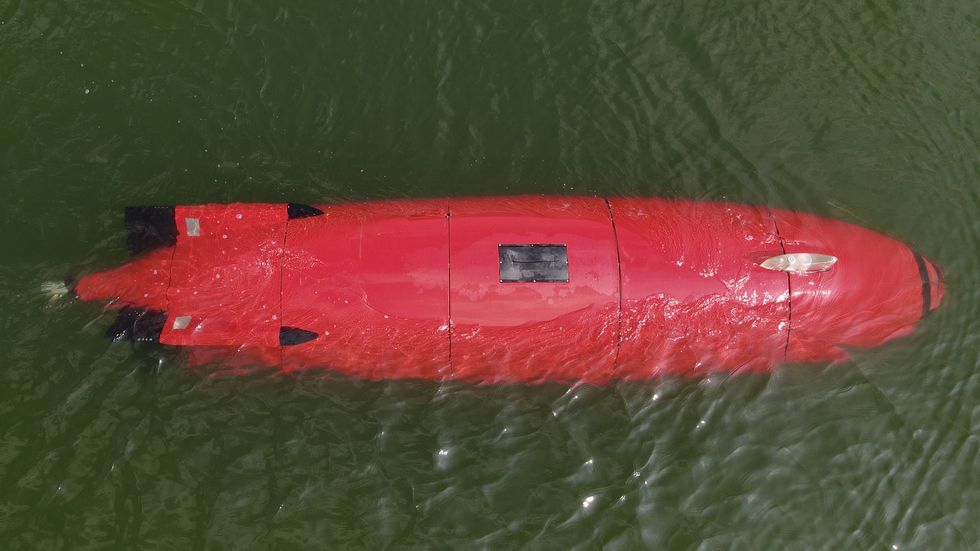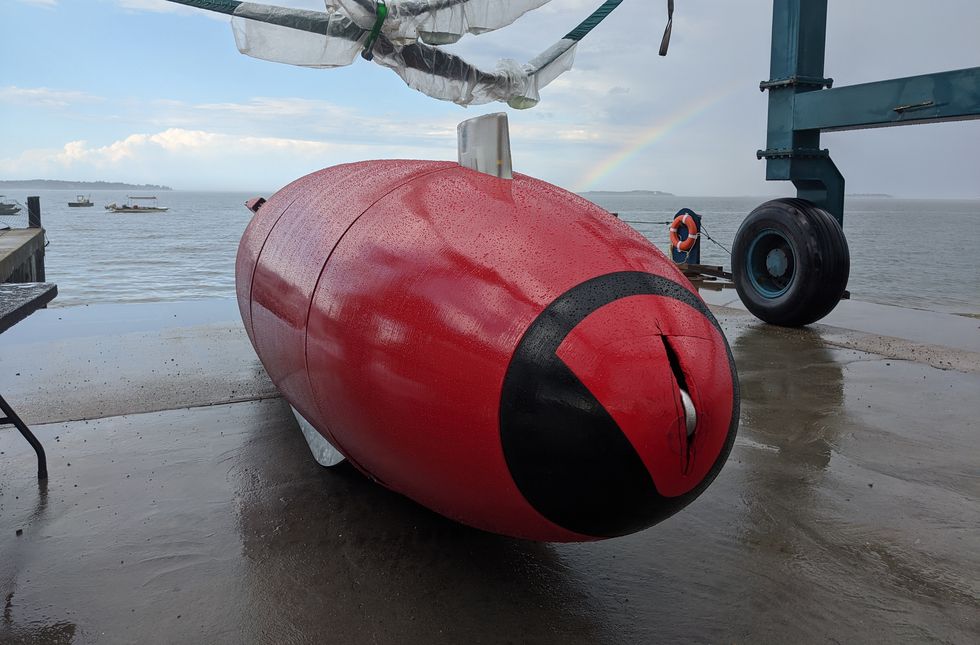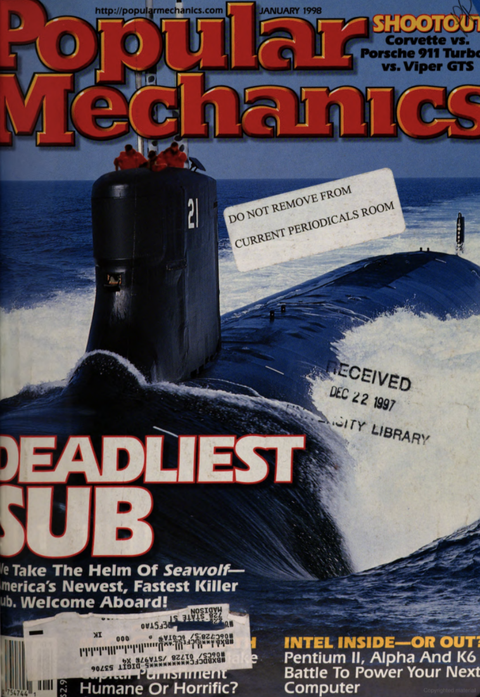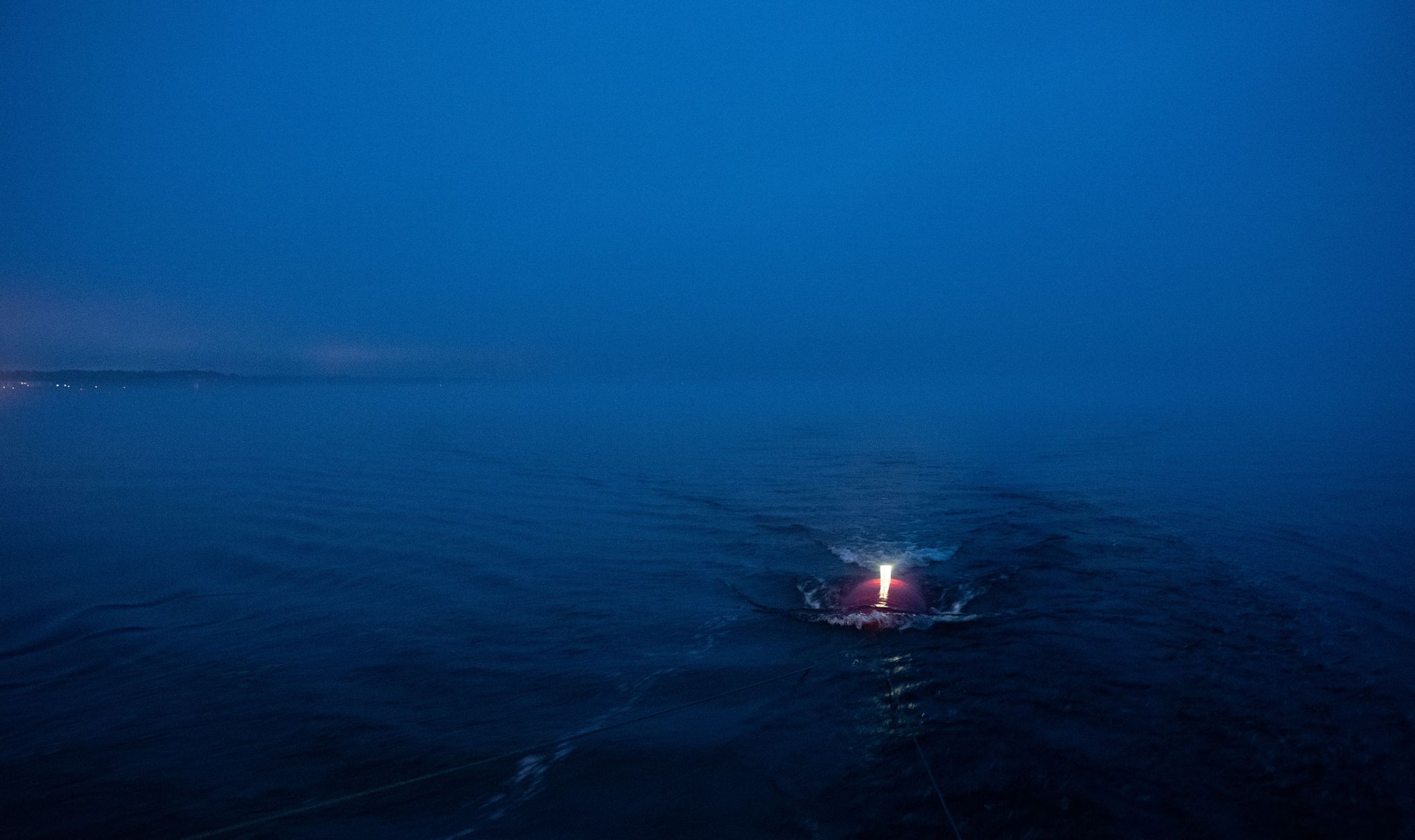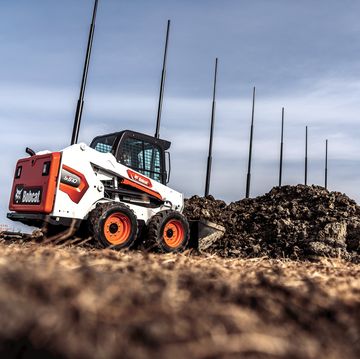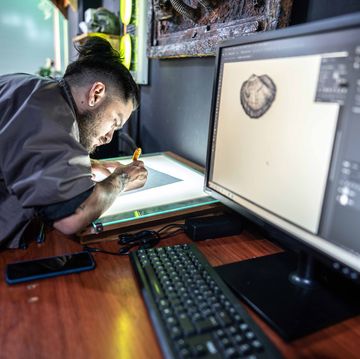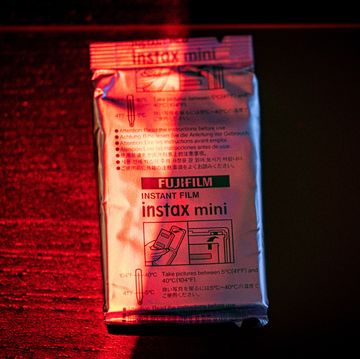At a passing glance, this robot submarine looks like any other.
It stretches a few feet longer and can putz around the ocean a bit farther, but its bulbous torpedo-shaped design is familiar to the first robotic subs that've plied the waters for decades. But a closer look at Dive Technologies' new sub reveals a quiet revolution—from how it works to how it's made.
This unassuming sub is a new breed of Autonomous Underwater Vehicles, or AUVs, future subs that are bigger, smarter, and can travel farther than ever before. They are rewriting the rules for underwater military, commercial, and scientific operations, and instead of building these water-delving behemoths in a traditional shipyard, ship makers are 3D printing them.
“Large AUVs will change everything,” says Sam Russo, COO of Dive Technologies. “They bring an enormous payload capability and energy capacity that allows the vehicles to operate on their own in the ocean for days on end.”
But Dive isn’t using your run-of-the-mill MakerBot. Using large scale 3D printers, the Boston-based startup can slash costs, speed up production, and create any submarine imaginable in just a few weeks—from idea to fully-functioning prototype.
What Makes an AUV?
Existing unmanned underwater vehicles, known commonly as UUVs, are small, torpedo-like craft with sonar, cameras, and other sensors. Operators lower them over the side of a ship to carry out survey missions with sonar, cameras, and other sensors, and recover them hours later. Most remain tethered to the mothership with a control cable so the operator can work them remotely, but AUVs can roam freely on pre-programmed missions.
Industrial UUVs routinely map the seabed and inspect underwater infrastructure for the oil and gas industry. Archeologists use them to map out underwater remains, and commercial UUVs locate and salvage wrecked ships and downed planes. Environmental scientists explore reefs, map currents, and track wildlife.
But like many areas of tech, AI is changing everything. With underwater robots becoming smarter and more capable, AI opens up the possibility of scaling them up so they can roam freely and carry out much longer operations measured in weeks rather than hours. In the case of the U.S. Navy’s Orca XLUUV, it’s three months.
Typical missions for large commercial AUVs will be seafloor surveys for oil and gas or deep sea mining, site inspection for offshore wind farms, and search and salvage—not so very different to existing jobs, except that the larger AUVs will work for far longer and cover larger areas. The submarine will travel up and down a swath of ocean in a lawn mowing pattern, using sonar to image the seafloor. It can avoid obstacles thanks to its onboard intelligence, and re-scan areas it might have missed, or closely investigate potential areas of interest.
But the biggest difference from existing small AUVs will be how operations are carried out. Rather than needing a manned surface vessel to take the robot to the right area, drop it off, and recover it, a long-range AUV can be launched from harbor and find its own way. Big AUVs can even carry out surveys in weather too rough for surface vessels.
U.S. Robot Subs: A Brief History
The U.S. Navy is a leader in unmanned underwater systems, but these are mainly small UUVs for hunting and disposing of underwater mines, or for mapping the littoral area around a coastline prior to amphibious operations. Now the Navy is pushing ahead with a slew of larger uncrewed vessels to take on missions traditionally carried out by manned submarines.
The charge is led by the Orca Extra-Large UUV currently being built by Boeing and scheduled to be in service for 2022, and the smaller Snakehead Large Diameter UUV in 2023. The details are classified, but Orca is believed to be even larger than Boeing’s Echo Voyager prototype which is 51 feet long and weighs 50 tons.
Submarines are used for all sorts of clandestine missions, from sneaking a peek at activity on foreign ports and photographing ships from underneath to placing sensors and tapping underwater communications cables. They may also seek or locate and trail enemy submarines. In wartime they can lay mines– the Navy is producing a new range of mines for covert delivery by unmanned submarines.
Unmanned subs can also act as "offboard sensors," a remote set of eyes and ears for a manned submarine. A larger robot submarine may act as a mothership for a fleet of smaller unmanned vessels, whether for intelligence gathering, neutralizing minefields or other tasks. They may even launch drones into the air for reconnaissance or strike missions.
And while the latest generation of manned submarines cost billions each and require a carefully-selected, highly-trained crew of over a hundred sailors, the four Orcas on order cost just $10m each. With 3D printing the cost may be driven even lower, allowing the Navy to acquire a massive ghost fleet of underwater robots, carrying out routine tasks and freeing up the larger manned vessels for missions which require human skill.
An AUV That’s Fit to Print
This emerging field of super-sized robot subs is dominated by Boeing and Lockheed Martin, building on their long history of delivering manned subs to the Navy.
But Dive Technologies say they can make large underwater robots better, faster, and cheaper—thanks to 3D printing. It's already built its first sub, the DIVE-LD, and with cooperation from the U.S. Naval Undersea Warfare Center (NUWC) and two contracts with DARPA, it’s safe to say that the Pentagon is interested in the new approach.
And that approach is truly radical.
Traditional submarine construction starts with the pressure vessel, an inner airtight hull strong enough to withstand the crushing weight of water at depth. Curved steel plates at least two inches thick are held in place with scaffolding and manually welded together, then strengthened with welded ribs.
“At the scale of Dive’s AUVs, it would not be prudent to envision manufacturing the way it has always been done which often involves large, expensive pressure vessels,” says Dive CTO Bill Lebo. “We had to completely rethink manufacturing.”
Strangely, Dive’s greatest design asset is that it didn’t have to worry about one important ingredient—a human crew. Without sailors and their needs for essential life-giving gases like nitrogen and oxygen, AUVs can be free-flooded, meaning water enters the body of the vehicle to equalize pressure instead of being kept outside an airtight hull.
So instead of a hard outer shell, DIVE-LD is built around an internal skeleton. The sub keeps its electronics brains and motors protected in small pressure vessels. The skeleton provides the load-bearing structure, and the outer skin provides a smooth, hydrodynamic surface. It’s a lot like how a traditional house places weight on its outer walls, while a modern skyscraper’s visible “skin” is draped over an extremely rigid skeleton.
Dive Technologies didn’t start in 2018 with the manufacturing process in mind. Instead, it naturally coalesced in order to meet an aggressive development schedule from idea to prototype.
Normally, a sub maker would set up machine tooling to produce a particular hull size. This can be extremely expensive, design-limiting, and time-consuming. A UUV design can take months until it’s finally in the water, or five years in the case of the Orca XLUUV. Dive Technologies didn’t have the time (or money) to wait around. The startup also had another problem—the sub design wasn’t even final. Dive needed flexible manufacturing—enter 3D printing.
For the last six years , companies have turned to large-format 3D printing to churn out items like self-driving cars and furniture, but fully autonomous submarines would be a first for the technology. Dive also created a ‘AUV Kit’ that would ensure all the necessary pieces from various suppliers could be easily assembled for the finished product, sort of like an IKEA sofa. The kit includes propulsion, power distribution, energy, communications, navigation, and computing—essentially everything that makes a sub go.
Additive Engineering Solutions in Akron, Ohio, printed the submarine’s skin in sections up to 4 feet across and 4 feet long. Each section can be printed in less than 36 hours. Nine large prints make up the sub’s body with another 85 3D printed parts in the interior.
The sub is made of different grades of ABS, the same material that makes up computer keyboards and LEGO bricks. However, in this case the ABS has composite reinforcement making it far stronger (like the glass fiber that gives fiberglass its strength).
These sections were fitted over the vehicle structure, the skeleton to which the engine, controls, and other systems are all attached. The skin was then finished for hydrodynamic smoothness and painted to complete the exterior.
“We went from an inventory of parts to a fully integrated AUV in three days, complete with a low-drag 3D printed skin,” says Tim Raymond, director of R&D. “Seeing the DIVE-LD come together so quickly and cleanly without any major speed bumps gave us an unexpected ‘ah-ha!’ moment.”
Detailed design took place in 2019, with the electronics build completed August 2020. After the DIVE-LD was assembled in four days, sea testing of the vehicle was completed in October.
A Submarine for Every Need
With the flexibility and speed of the AUV Kit and 3D printing, Dive Technologies could theoretically build any submarine imaginable—for whatever purpose and at whatever size. All it would take are a few design tweaks, a day-and-half of 3D printing, and a AUV Kit to make any submarine possible.
“It didn’t matter what the vehicle actually looked like; we had the manufacturing process and architecture to rapidly create AUVs to meet any mission,” says Raymond.
The current engine is a 6-kW electric direct drive thruster with a magnetic coupling to the propeller.. Top speed is 6 knots/7 mph, similar to other AUVs, but different engines could be installed if required.
The initial DIVE-LD is 48 inches in diameter and 19 feet long, but the company says that can be easily scaled up to 7 feet in diameter and really any length required. Even 7 feet is not an absolute limit—but Dive Technology would need to upgrade their logistics to handle larger vehicles.
If you need shrink things down a bit, designs can also be scaled down to about 20 inches diameter. And all of it—from initial design to first test dives—only takes a few weeks.
While Dive Technologies AUVs looks like an average sub on the outside, the inside is anything but.
Traditional submarines rely on their pressure hulls with additional welded T-shaped ribs for strength. In WWII, U-boats had a ‘collapse depth’ of less than 1,000 feet. The depth ratings of current submarines are classified but the current U.S. Navy Seawolf is said to be able to reach 2,000 feet.
The DIVE-LD with its internal pressure vessels can withstand a bone-crushing 20,000 feet, and it takes highly specialized skills to ensure everything is able to cope with the pressure and other factors and still function reliably.
“There’s really only a small portion of the engineering population that truly understands how to build equipment that can operate in the harsh ocean environment,” says Lebo.
While traditional AUVs operate for short periods and follow pre-programmed routes, larger AUVs need onboard intelligence. The DIVE-LD has ten-day endurance and a range of more than 600 miles. While it can surface to communicate if needed, it needs to react to the unexpected and re-plan its route if it runs into obstacles.
Dive Technologies partnered with Metron to provide the necessary brains. Metron has provided autonomy software to the U.S. Navy and DARPA for avoiding other vessels, detecting underwater obstacles and planning a path around them, and efficient route planning. Metron’s software carries out dynamic mission re-tasking, meaning it can respond to changing circumstances as they occur.
Metron’s software includes "look-ahead methods" where the vehicle plays out possible future scenarios in internal simulations, then chooses the path that best fits its mission. The control system also monitors faults and provides the sub’s “get home capability, ” according to DIVE’s CEO Jerry Sgobbo.
“This capability enhances mission reliability for our customers and overall survivability of the DIVE-LD platform, particularly when you consider the long range and endurance.”
A Robotic Future
Lebo says future DIVE-LD variants will have robotic arms and a ‘hovering’ capability for maintenance and repair jobs on underwater infrastructure like pipelines. He also anticipates hardware for recharging and data downloads at sea, so the AUV will be able to stay out indefinitely.
In the military, large AUVs will extend the existing mine countermeasures capabilities to fully autonomous mine-hunting and destruction missions. One day, they might even be armed with torpedoes or other weapons, the underwater equivalent of the USAF’s Loyal Wingman drones, though the Pentagon current rules mean a human must always decide when to fire.
The DIVE-LD is currently being fitted with sonar sensors and carrying out offshore demonstrations, and is now available as a ‘robot-as-a-service model’—where customers hire out an AUV for a particular task.
For more than a century, the underwater world has been ruled by crewed submarines. But the future is robotic—filled with autonomous subs going about their missions unseen, unheard, and uncrewed.


